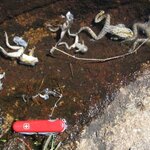Environment

I now make 10 times more compost with 1/50 the work and energy compared with how I did it over 35 years ago, when I turned it everyday. I reuse or recycle everything I can, and picked up some field fencing someone threw away.
I made a bunch of cylinders out of the fencing as large as I could easily move around. The most work and energy wasted is moving the compost. Put the cylinders where the future garden beds will be and layer them with small cut brush, organic material, manure, and dirt. Do this layer after layer , when they are done cover with dirt this will filter through the pile…

Amphibians, reigning survivors of past mass extinctions, are sending a clear, unequivocal signal that something is wrong, as their extinction rates rise to unprecedented levels, according to a paper published by the Proceedings of the National Academy of Sciences (PNAS). Humans are exacerbating two key natural threats – climate change and a deadly disease that is jumping from one species to another.
The authors confront the question of whether Earth is experiencing its sixth mass extinction and suggest that amphibians, as a case study for terrestrial life, provide a clear answer. "A general…

Do volunteers who take part in conservation efforts do it for the wildlife they are trying to protect or just to impress their friends and because they like the way wildlife looks on their property? A University of Alberta case study says it is not altruism that drives them.
A study of purple martin landlords, those who keep and monitor special birdhouses on their land, revealed that they were more motivated to take part in the conservation project for egoistic rather than altruistic reasons.
"Though there were areas of overlap, we found that common motivations for self-benefit included…

A snapshot of New Zealand's climate 40 million years ago reveals a greenhouse Earth, with warmer seas and little or no ice in Antarctica, according to research published this week in the journal Geology.
The study suggests that Antarctica at that time was yet to develop extensive ice sheets. Back then, New Zealand was about 1100 km further south, at the same latitude as the southern tip of South America – so was closer to Antarctica – but the researchers found that the water temperature was 23-25°C at the sea surface and 11-13°C at the bottom.
"This is too warm to be the Antarctic water we…

Bring on the bad weather. A single typhoon in Taiwan buries as much carbon in the ocean (in the form of sediment) as all the other rains in that country all year long - combined.
The study published in Geology the first to examine the chemistry of stream water and sediments that were being washed out to sea while a typhoon was happening at full force. This new knowledhe should help scientists develop better models of global climate change.
Anne Carey, associate professor of earth sciences at Ohio State, said that she and her colleagues have braved two typhoons since starting the project in…

Wealthy nations willing to collectively spend about $1 billion annually could prevent the emission of roughly half a billion metric tons of carbon dioxide per year for the next 25 years, says a new study. It would take about that much money to put an end to a tenth of the tropical deforestation in the world, which would lead to lower greenhouse gas emissions, they say, and reduce global carbon emissions by between 2 and 10 percent.
The calculation is one of several estimates described by a team of scientists and economists this week in the online edition of Proceedings of the National…

The results of a new study suggest that past climate changes and sea level fluctuations may have promoted the formation of new species in the Amazon region of South America.
The Amazon basin is home to the richest diversity of life on earth - some place had to be it - yet the reasons why are not well understood. A team of American and Brazilian researchers studied three species of leafcutter ants from Central and South America to determine how geography and climate affect the formation of new species.
Climate changes during the last ice age affected where Amazonian species, such as…

Modern engine oil is a complex, highly engineered lubricating mixture, up to 20 percent of which may be special additives to enhance properties such as viscosity and stability and to reduce sludge formation and engine wear.
For years antiwear additives for high-performance oils have been phosphorous compounds, particularly zinc dialkyldithiophosphate (ZDDP), that work by forming a polyphosphate film on engine parts that reduces wear. Unfortunately phosphorus is a chemical poison for automobile catalytic converters, reducing their effectiveness and life span, so industry chemists have been…

A new fossil discovery, the first of its kind from the whole of the Antarctic continent, provides scientists with new evidence to support the theory that the polar region was once much warmer.
The discovery by an international team of scientists was published in Proceedings of the Royal Society B and involved researchers from the University of Leicester, North Dakota State University, the British Geological Survey, Queen Mary University of London, and Boston University.
The team made a new fossil discovery in the Dry Valleys of the East Antarctic region. The fossils (ostracods) come from an…

Environmental factors can transform the ratio of females to males in plant populations according to new research out of the University of Toronto.
The study conducted by Ivana Stehlik, a lecturer, Jannice Friedman, a PhD candidate, and Spencer Barrett, a professor, involved a novel approach using genetic markers (known DNA sequences) to identify the sex of seeds. The team investigated six natural populations of the wind-pollinated herb Rumex nivalis in the Swiss Alps and mapped the distance between females and neighbouring males. They then measured the amount of pollen captured by female…